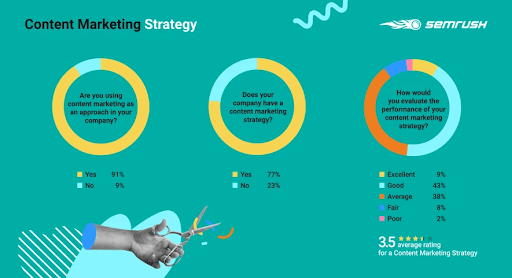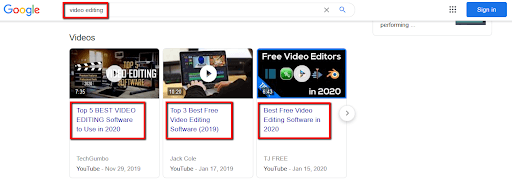5 techniques to use SEO data to make better content marketing decisions
Did you know that 91% of marketers use content marketing as an approach in their organizations?
It’s clearly gaining momentum.
But not all is sunshine and roses.
The same survey also showed that 48% of marketers believe that their content marketing strategies are either average, fair, or poor.

Image via SEMrush
That brings us to the question:
What can marketers do to drive content marketing ROI?
The answer lies in leveraging SEO data.
To create an effective content marketing strategy, marketers need to take a closer look at their SEO insights.
In this article, let’s take a look at how you can amplify your content marketing efforts through SEO insights.
5 techniques to leverage SEO to boost your content marketing efforts
Let’s get this straight:
SEO and content marketing are complementary approaches.
While SEO can help you figure out what your audience is looking for, content marketing enables you to deliver exactly what they want.
To create insightful content, leveraging search data can give you an edge over your competitors. Here is how you can use SEO data to guide your content marketing strategy:
1. Find out what your audience is searching for
Keywords are at the heart of any SEO strategy. By taking a closer look at the most popular keywords in your niche, you can get a whiff of what your target audience is looking for online.
To find your website’s most popular keywords, you can use Google Search Console. It will show you a list of search queries that users have typed to read your site content.
What’s more, you can understand a user’s search intent via keywords. All you need to do is Google a keyword and check out the top results on the SERPs.
For instance, when you look up the results for the keyword “video editing,” you’ll find results related to the best editing software.
This indicates that users may not be looking for tips related to video editing. Instead, their intention while typing the keyword is likely to find the best software for editing their videos.

Image via Google
Looking at the search intent can help you find fresh content ideas and gaps in your content marketing strategy. It’s also a good idea to organize your keywords based on intent.
For this strategy, make sure you check the SERP results in an incognito window for more accurate information.
2. Identify your top-performing content
Through analytics tools like Search Console, Google Analytics, and SEMrush, you can check out the number of impressions and clicks received for all your published content.
To get insights from this SEO data, you can look for answers to the following questions:
- Which posts get the highest number of impressions?
- Is any post ranking on page one of the SERPs?
Once you find the answers, you’ll know which content on your site is the most popular. With these insights, you can further amplify your content’s reach and engagement via email marketing.
This strategy can even help you boost your revenue. After all, for each dollar that a business spends on email marketing, they can earn on average $40.
Isn’t that great?
All you need to do to leverage this strategy is repurpose your blog posts into email newsletters. It doesn’t take much effort but can yield great returns.
Pro Tip: Leverage tools for email marketing to amplify your reach.
3. Learn from your competitors’ strategies
Through competitor research and analysis, you can get a sneak peek into your competitors’ strategies. From their top keywords to backlinks and traffic data, you can check everything out.
Wondering how that can help your content marketing efforts?
Not only can you identify new content ideas, but you can also find new linking opportunities for your website. Analyzing what works for them can help you polish your strategy as well.
4. Track how your audience interacts with your content
Tracking and analyzing your traffic can help you find gaps in your overall content marketing strategy. Let’s say, multiple users bounce off your site after reading the first paragraph of your article. This may indicate that the content in it isn’t engaging enough.
Once you find the bottlenecks, you can fix those issues for better results. For this, you can use A/B testing and CRO tools to analyze how users interact with your content and what leads to more conversions.
To get a better idea of what works, look for specific changes. It could include anything from publishing a new headline and to changing the placement of your CTA button.
With the results, you can make changes to the content that is already published. You can also be more cognizant of these changes while writing your future articles.
5. Pay attention to in-site traffic
What do you do when you want to look for a particular article on your favourite website? Chances are you type a keyword related to the article in the search bar.
Your site audience is likely to do the same.
When users can’t find what they are looking for, they may have tried searching for it. By pulling out the data from your site’s search bar, you can unlock a goldmine of ideas to create share-worthy content. You may find a topic or a keyword that you may not have covered yet.
Here is how you can find this data:
- Log into your Google Analytics account.
- Go to the “Site Search Report” that is listed under the “Behaviour” section.
- Check out the data for the used search terms.
If a particular search term is featured frequently in the report, it means that people want to read about it. That’s your cue to create an article related to it.
Conclusion
SEO and content marketing overlap on multiple levels. To amplify your online presence, both of these strategies should go hand in hand. By leveraging your SEO data, you can identify gaps in your content strategy and come up with new content ideas.
In addition to this, you can identify linking opportunities and get an idea about your competitors’ strategy. Your SEO data holds the key to creating a winning content marketing strategy. With careful analysis, you can take your content game to the next level.
Author biography
Shane Barker is a digital marketing consultant for 15 years with an emphasis on Influencer Marketing in the last 5 years. He is specialized in sales funnels, targeted traffic and website conversions. He has consulted with Fortune 500 companies, Influencers with digital products, and a number of A-List celebrities.








